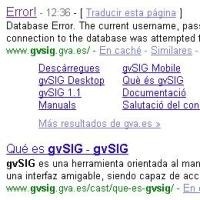![clip_image002[1] clip_image002[1]](/wp-content/uploads/2011/05/clip_image00211.gif) This week has been released the stable version of gvSIG 1.9, from which we had the RC1 in August and the Alpha version in December 2008.
This week has been released the stable version of gvSIG 1.9, from which we had the RC1 in August and the Alpha version in December 2008.
This version will possibly make history, because maturity is enough to promote it for municipal use, without being belittled by smallness made by ArcView 3x and not done by gvSIG 1.3.
They have faithfully fulfilled the promised improvements in the Alpha version, what has been marked in red is extra; it was not mentioned in that first.
| SIMBOLOGY – Legend for points’ density. – Symbols editor. – Legend of graduate symbols. – Legend of proportional symbols. – Legend quantities by category. – Levels of symbolism. – Read/write SLD legends. – Base game symbols. – Two different measurement systems for symbols and labels (on paper / in the world). – Legends-based on filters (Expressions). |
| LABELING – Creation of individualized annotations. – Control of the labeled overlaps. – Priority in placement of the labels. – Display labels in a range of scales. – Orientation of labels. – Different options to placement labels. – Support a greater number of units of measurement for labels. |
| RASTER AND REMOTE SENSING – Cutting data and bands – Export of layers – Save to raster a section of the view – Tables of color and gradients – Treatment of nodata value – Processing per pixel (filters) – Treatment of color rendition – Generation of pyramids – radiometric enhancements – Histogram – Geolocation – Raster Reprojection – Georeferencing – Automatic Vectorization – Algebra of bands – Definition of areas of interest. – Supervised classification – Unsupervised Classification – Decision trees – Transformations – Image Fusion – Mosaics – Scatter diagrams – blending image profiles Some of them seem not to be found, as it has been reported in the user list SEXTANTE is neither automatically installed. |
| INTERNATIONALIZATION – New languages: Serbian, Swahili, Greek and Russian. – Integrated Translation Management extension. English (USA), Portuguese Brazilian, Turkish. |
| EDITION – Matrix. – Scaling. – New snapping. – Cut polygon. – AutoComplete. – Join polygon. – Exploit. |
| TABLES – New wizard for joining tables. |
| GEOPROCESSING:
– Extension of geoprocessing tools that can work with layers lines besides with layers of polygons |
| MAPS – Add grid to a view within the Layout. |
| PROJECT -Wizard for recovery layers whose path has changed (only SHP) – Online help. |
| INTERFACE – Possibility for the user to hide toolbars. – New Icons. |
| CRS Extension management of CRS JCRS v.2 integrated. |
| OTHERS – Improvements in reading the DWG 2004 format – Improvements in the functioning and utility of the hyperlink. – Memorize the path where are the legends of symbology. – Include GeoServeisPort in the nomenclator. – Distance Units independent from area units. – Enter to Properties with double click. |
| It has been included in the Environmental Council of Castilla de Leon the following, although some have been suggested from the GPS on the user lists. |
| SELECTION TOOLS – Polyline selection. – Circle selection. – Selection by area of influence (buffer). – Select all. INFORMATION TOOLS
TRANSFORMATION DATA TOOLS – Add geographical information to the layer (adding fields “Area”, “Perimeter”, etc. To a table with a couple of clicks). OTHERS |

Now is half complicated to download it, because the web is half down three of every two days, aspect that seems to be the fault of another side.
If it is alive, you can download it from here
If not, this is another choice with JRE or without JRE and from FTP
Greetings, we’ll proof it next week.
 Autocad Software, Bentley Microstation, Gis Google Earth, Gis System Geomate Provides Services For Complete Gis Software And Solutions, Autocad Software, Autocad Courses, Bentley Microstation, Microstation Software, Gis Google Earth, Open Source Gis And More.
Autocad Software, Bentley Microstation, Gis Google Earth, Gis System Geomate Provides Services For Complete Gis Software And Solutions, Autocad Software, Autocad Courses, Bentley Microstation, Microstation Software, Gis Google Earth, Open Source Gis And More.